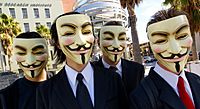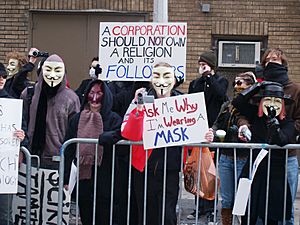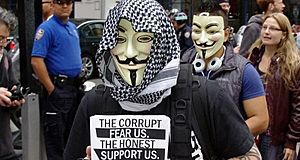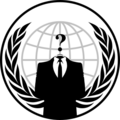Anonymous (hacker group) facts for kids

An emblem that is commonly associated with Anonymous. The "man without a head" represents anonymity and leaderless organization.
|
|

Individuals appearing in public as Anonymous, wearing Guy Fawkes masks
|
|
| Formation | c. 2003 |
|---|---|
| Type |
|
| Purpose |
|
|
Membership
|
Decentralized affinity group |
Anonymous is a group of people who come together online to act as activists and "hacktivists." They are known for their computer attacks against governments, companies, and other organizations.
The group started around 2003 on a website called 4chan. It represents the idea that many online users can act as one big "global brain" or "hivemind." Members of Anonymous, sometimes called anons, often wear Guy Fawkes masks in public. This mask is from the movie V for Vendetta. Some anons also hide their voices using voice changers or computer programs.
Many people have been arrested for being involved in Anonymous's computer attacks. This has happened in countries like the United States, the United Kingdom, and Australia. People have different opinions about Anonymous. Some call them "freedom fighters" or digital Robin Hoods. Others see them as "cyber terrorists." In 2012, Time magazine named Anonymous one of the "100 most influential people" in the world. The group became less active by 2018 but reappeared in 2020 to support the George Floyd protests and other causes.
Contents
- What Anonymous Believes
- How Anonymous Started
- Early Days and 4chan (2003–2007)
- Encyclopedia Dramatica (2004–Present)
- Project Chanology (2008)
- Operation Payback (2010)
- Anonymous Actions (2011–2012)
- Anonymous Actions (2013)
- Anonymous Actions (2014)
- Anonymous Actions (2015)
- Anonymous Actions (2016)
- Anonymous Actions (2020)
- Anonymous Actions (2022)
- Groups Connected to Anonymous
- Arrests and Legal Cases
- Anonymous in Media
- See Also
- Images for kids
What Anonymous Believes
Anonymous is a group with no single leader. It works based on ideas rather than strict orders. It's hard to know what every member thinks because there are so many of them.
Generally, anons are against Internet censorship and control. Most of their actions target groups they accuse of limiting online freedom. They supported the global Occupy movement and the Arab Spring protests. Since 2008, there has been some debate within Anonymous. Some members prefer pranks and entertainment, while others focus on more serious activism.
One common idea among members is to "do as you wish." They often say, "we are doing it for the lulz," meaning they do things for fun or amusement.
Because Anonymous has no leader, no action can be blamed on the whole group. Anyone who believes in Anonymous and calls themselves Anonymous can be a part of it. It's like a large, changing crowd of people working together for different reasons.
A few unwritten rules for members include not sharing your real identity and not attacking the media. A common saying they use is: "We are Anonymous. We are Legion. We do not forgive. We do not forget. Expect us."
How Anonymous Started
Early Days and 4chan (2003–2007)
The name Anonymous comes from how users post online without showing their names. On websites like 4chan, users often posted as "Anonymous." People started joking that "Anonymous" was one person. In 2004, 4chan made it so all posts were signed as Anonymous. As these websites grew, the idea of Anonymous as a group of unnamed people became a popular Internet meme.
Users of 4chan would sometimes team up for mass pranks. For example, in 2006, many 4chan readers went to the social site Habbo Hotel. They used identical characters to block others from the virtual pool. These pranks led to the first news story about Anonymous. A Fox TV station called them "hackers on steroids" and an "Internet hate machine."
Encyclopedia Dramatica (2004–Present)
Encyclopedia Dramatica was started in 2004. It became a main platform for Anonymous to share funny content and other things. This website documents Internet memes and events like mass pranks and online security failures. It also criticizes online groups that try to censor themselves.
In 2011, the original site changed a lot. Some Anonymous members launched "Operation Save ED" to bring back the old content. The site later returned under a new address.
Project Chanology (2008)
Anonymous became known for hacktivism in 2008. This was after they took action against the Church of Scientology. In January 2008, a video of celebrity Scientologist Tom Cruise was posted online. The Church tried to remove it, saying it broke copyright rules. In response, 4chan users attacked the Church. They prank-called its hotlines, sent black faxes to waste ink, and launched DDoS attacks on its websites.

During these attacks, Anonymous uploaded a video to YouTube. A computer voice said Anonymous would "expel you from the Internet" for the good of mankind and "for the laughs." This video quickly got hundreds of thousands of views.
With many followers online, Anonymous decided to hold a worldwide protest. They chose the Guy Fawkes mask as a symbol. This mask is from V for Vendetta, a movie about a revolutionary fighting a strict government. On February 10, thousands of Anonymous members protested at Scientology centers in 142 cities across 43 countries. The Guy Fawkes mask quickly became a symbol for Anonymous.
Operation Payback (2010)
By 2009, actions against Scientology had mostly stopped. In September 2010, Anonymous learned about Aiplex Software. This Indian company used DDoS attacks against websites that shared copyrighted movies. Anonymous launched a DDoS attack on Aiplex's website, shutting it down for a day. They then targeted the Recording Industry Association of America (RIAA) and the Motion Picture Association of America (MPAA), taking down both sites.
On September 19, members hacked the website of Copyright Alliance. They posted the name of their operation: "Operation Payback." Anonymous also said they were tired of companies controlling the internet and stopping people from sharing information.
In November 2010, WikiLeaks started releasing many secret U.S. government documents. When companies like Amazon.com, PayPal, MasterCard, and Visa stopped working with WikiLeaks, Anonymous started "Operation Avenge Assange." They launched DDoS attacks against PayPal's blog and other sites that had stopped supporting WikiLeaks.
The attacks briefly took down PayPal.com, Visa, and MasterCard websites. PayPal later shared the IP addresses of 1,000 attackers with the FBI. This led to at least 14 arrests.
Anonymous Actions (2011–2012)

After Operation Payback, Anonymous's targets became more varied. In 2011, they supported Arab Spring movements with "Operation Tunisia." They helped Tunisians protect their web browsers from government spying. They also helped people share videos about the uprising.
In February 2011, anons attacked Aaron Barr, CEO of a computer security company. They did this because he was researching Anonymous members. They hacked his company's site, changed his Twitter, and released many of his company's emails. This caused big problems for his firm.
Anonymous has also targeted groups accused of being against certain people. In 2011, they threatened the Westboro Baptist Church, known for protesting funerals. They published names and addresses of church members and took down their website. In 2012, they hacked the site of Uganda's Prime Minister. This was in response to a law that would allow harsh punishments for homosexual people.
In April 2011, Anonymous attacked Sony. This was because Sony tried to stop people from hacking the PlayStation 3 game console. More than 100 million Sony accounts were affected. Sony's online services were down for a month.
In August 2011, Anonymous launched #OpBart against BART in San Francisco. This was after a person was killed by police. The attack leaked customers' personal information.
When the Occupy Wall Street protests began in New York City in September 2011, Anonymous members joined early. They helped spread the movement to other cities.
In January 2012, the U.S. government shut down the file-sharing site Megaupload. Anonymous responded with DDoS attacks on U.S. government and copyright websites, shutting them down.
In April 2012, Anonymous hacked 485 Chinese government websites. They did this to protest how China treats its citizens. They urged people to "fight for justice, fight for freedom, [and] fight for democracy."
In November 2012, Anonymous took down hundreds of Israeli websites. This was in response to an Israeli military operation in the Gaza Strip.
Anonymous Actions (2013)
On November 5, 2013, Anonymous protesters gathered around the world for the Million Mask March. Demonstrations were held in 400 cities on Guy Fawkes Night.
"Operation Safe Winter" started in November 2013. It aimed to help homeless people by collecting and sharing resources. This project encouraged public participation and partnered with groups not usually linked to Anonymous.
Anonymous Actions (2014)
After the fatal police shooting of Michael Brown in Ferguson, Missouri, a group claiming to be Anonymous started "Operation Ferguson." They organized online protests against the police. They said they would attack the city's computers if protesters were harmed. City officials reported that email systems were targeted.
In November 2014, Anonymous declared "cyber war" on the Ku Klux Klan (KKK). This was after the KKK made threats following the Ferguson riots. They hacked the KKK's Twitter account and released personal details of members.
On November 24, 2014, Anonymous shut down the Cleveland city website. This was after Tamir Rice, a twelve-year-old boy, was shot by a police officer.
Anonymous Actions (2015)
In January 2015, Anonymous released a video condemning the Charlie Hebdo shooting. They said it was a message for al-Qaeda and the Islamic State. They promised to "declare war" on terrorists and shut down their social media accounts. They later took down a website believed to belong to one of these groups.
In June 2015, Anonymous claimed responsibility for an attack on Canadian government websites. This was to protest a new anti-terror law.
In October 2015, Anonymous said they would reveal the names of up to 1,000 KKK members. They stated, "The privacy of the Ku Klux Klan no longer exists in cyberspace." They planned to release the names on November 5.
In November 2015, Anonymous announced a big operation against ISIS after the November 2015 Paris attacks. They declared: "Anonymous from all over the world will hunt you down." Anonymous claimed to have taken down thousands of pro-ISIS Twitter accounts. However, some of the accounts they listed were still active and belonged to regular people.
A group called AnonSec, claiming to be part of Anonymous, said they hacked NASA servers in 2015. They claimed to have taken a lot of data, including flight logs and videos. NASA denied that their drone controls were ever compromised.
Anonymous Actions (2016)
The Blink Hacker Group, linked to Anonymous, claimed to have hacked Thailand prison websites in 2016. They said they did this because of news about mistreatment of prisoners.
In late 2017, the QAnon conspiracy theory appeared. Its followers used similar terms and symbols as Anonymous. In response, some Anonymous members said QAnon was stealing their brand and vowed to oppose the theory.
Anonymous Africa launched attacks on websites linked to the Gupta family in South Africa in 2016. They also attacked websites of other groups for political reasons.
Anonymous Actions (2020)
In February 2020, Anonymous hacked the United Nations' website. They created a page for Taiwan, which has not had a seat at the UN since 1971.
After the murder of George Floyd in the U.S., Anonymous released a video in May 2020. They said they would seek revenge on the Minneapolis Police Department and "expose their crimes to the world." The Minneapolis police website went down. However, some claims about hacking police radio or widespread attacks were later found to be false.
In June 2020, Anonymous published BlueLeaks. This was a large amount of internal U.S. law enforcement data. It included intelligence, emails, and reports from over 200 agencies. The data showed that some law enforcement was spying on people who were legally protesting.
In 2020, Anonymous started cyber-attacks against the Nigerian government. They supported the #EndSARS movement in Nigeria. They took down government websites and affected some bank websites.
Anonymous Actions (2022)
On February 25, 2022, Anonymous accounts on Twitter said they launched "cyber operations" against Russia. This was in response to the 2022 Russian invasion of Ukraine. The group temporarily disabled websites like RT.com and the Russian Defence Ministry. Anonymous also leaked emails from a Belarusian weapons company that helped Russia. They also hacked Russian TV channels to play Ukrainian music and show uncensored news about the war.
Operation Russia
In March 2022, Anonymous members said they hacked 400 Russian surveillance cameras. They broadcast the camera feeds online.
Between March and June 2022, many gigabytes of emails and documents were leaked. These were allegedly from the Central Bank of Russia and other Russian companies and government groups.
Iranian Protests
Anonymous launched cyber operations against the Iranian government. This was for the alleged murder of Mahsa Amini. They launched DDoS attacks against Iran's government websites. In September 2022, the official website of Ayatollah Ali Khamenei was taken down. Another hacktivist group also hacked Iran's state TV channel during a broadcast.
China Protests
In response to the 2022 COVID-19 protests in China, Anonymous launched "Operation White Paper." They attacked Chinese government websites and leaked some personal information of Chinese officials.
Groups Connected to Anonymous
LulzSec
In May 2011, a small group of Anonymous members formed "Lulz Security," or "LulzSec." Their first attack was against Fox.com. They leaked passwords and other information. In May 2011, LulzSec gained attention for hacking the Public Broadcasting Service (PBS) website. They stole user data and posted a fake story. LulzSec said some of their hacks were to defend WikiLeaks.
In June 2011, LulzSec claimed to have attacked Sony Pictures. They took data like names, passwords, and home addresses of thousands of people.
LulzSec also attacked government-linked sites. They leaked emails and passwords from the U.S. Senate website. They also took down the public website of the U.S. Central Intelligence Agency (CIA) for several hours.
In June 2011, the main LulzSec group said they were stopping their operations. However, some members were later arrested.
AntiSec
Starting in June 2011, hackers from Anonymous and LulzSec worked together on "Operation AntiSec." In June, they released documents from the Arizona Department of Public Safety. This included personal information of law enforcement officers. This was in response to a new immigration law. Other data leaks included personal details of police officers in other U.S. states.
In July 2011, LulzSec hacked the website of the British newspaper The Sun. This was in response to a phone-hacking scandal. AntiSec also targeted computer security firms and defense companies. They released many military email accounts and passwords.
In December 2011, AntiSec members hacked Stratfor, a U.S. intelligence company. They published credit card numbers and later released millions of the company's emails to Wikileaks.
Arrests and Legal Cases
Since 2009, many people have been arrested for being involved in Anonymous computer attacks. This has happened in several countries. Anonymous members often protest these arrests and see the arrested individuals as heroes for their cause.
The first person sent to jail for an Anonymous DDoS attack was Dmitriy Guzner, a 19-year-old American. He was sentenced to 366 days in prison in 2009.
In June 2011, officials in Turkey arrested 32 people. They were suspected of being involved in DDoS attacks on Turkish government websites.
Chris Doyon, who called himself a leader of Anonymous, was arrested in 2011 for a cyberattack. He later fled to Canada.
In September 2012, journalist Barrett Brown, who often spoke for Anonymous, was arrested. He was charged with many offenses, including publishing credit card information from the Stratfor hack.
Operation Avenge Assange Arrests
Several law enforcement agencies took action after Anonymous's "Operation Avenge Assange." In January 2011, British police arrested five suspects. In July 2011, over 20 arrests were made in the U.S., UK, and Netherlands.
One of the organizers of DDoS attacks, Christopher Weatherhead, was found guilty in the UK in 2012. He was sentenced to 18 months in prison.
Anonymous in Media
Sam Esmail, the creator of the TV show Mr. Robot, said he was inspired by Anonymous. The show features a hacker group called the "Omegas," which is a clear reference to LulzSec. In the TV series Elementary, a hacker group called "Everyone" also appears. This group has many similarities to Anonymous.
See Also
 In Spanish: Anonymous para niños
In Spanish: Anonymous para niños
Memetic persona
Composition
|
Activism
Other related articles
|
Images for kids









